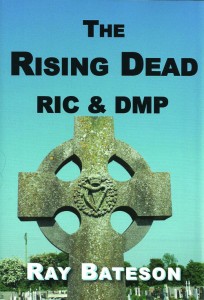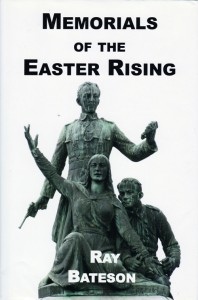The Rising dead: RIC & DMP
Published in Issue 3 (May/June 2014), Reviews, Volume 22RAY BATESON
Irish Graves Publications
£17.50
ISBN 9780954227531

If Ray Bateson was lucky enough to be a tenured professor of modern Irish history with an army of research students chomping at the bit for a mention in the credits of one of his books one can only imagine the output he might achieve. He has set himself the Herculean task of recording and writing about the many souls who lost their lives as a result of the Easter Rising. Compare the figures for casualties in any book pertaining to 1916 and inevitably each one will provide a different and inaccurate tally. Bateson plans to search meticulously through the available records to remedy this situation and provide a correct figure not just for the republicans and socialists who died, not just for the police and military, but also for the civilians. The Rising dead: RIC & DMP concerns the fourteen members of the Royal Irish Constabulary and three members of the Dublin Metropolitan Police who died as a result of the Rising; it counterbalances his awkwardly titled They died by Pearse’s side (2010) about the Volunteers and ICA killed or ex-ecuted in 1916.
RIC & DMP will be of interest to anyone who follows the line that Countess Markievicz was responsible for shooting dead Constable Lahiff in St Stephen’s Green. Bateson writes that rumours started immediately after the Rising. The New York Times reported that she had ‘shot dead a guard in front of Dublin Castle’ (Constable O’Brien had indeed been shot there, but by Seán Connolly). The Kildare Observer ‘heard ghastly tales of her having shot two sentries with a revolver and being shot dead in return by the military’ (sic). They did note, though, that rumour ‘has never been so busy and rumour has never been so lying as during the past ten days’. Bateson writes at length about ‘two typed pages of a diary’ from a nurse (Fitzgerald) who claimed to have witnessed the shooting. He questions the authenticity of the diary and the accuracy of the author’s memory of the event. Although he cannot categorically prove that Markievicz did not shoot Lahiff, he does raise a few questions about what is now regarded as an established ‘fact’ but should at most be an allegation, if not merely a rumour. Bateson is sober in his reflection about the killing:
‘Unfortunately, the death of Constable Lahiff has been completely overshadowed by the controversy about whether or not Countess Markievicz shot him. As we approach the centenary of his death, it is now time to put him back at the centre of the tragedy that overtook his colleagues, parents, brothers and sisters.’
Bateson also raises the intriguing and tragic story of Constable Hetherton (also known as Hethertain), who died in Dublin Castle of ‘septic pneumonia from incisor wound of the neck’. According to the Red Cross this wound was self-inflicted but the family always questioned this, as it would clearly have been easier to shoot himself than to use a blade. Bateson believes that he may have slashed himself and sympathetically examines the hardship and pressure that DMP and RIC men were under at the time,
‘. . . confined to barracks, when men, women and children were being killed by all sides on the streets of Dublin, and this may have given rise to a sense of failure or shame in a conscientious policeman with a heightened sense of duty. In addition there was great tension, lack of food, wild rumours, getting shot at, executions and many experiences that could have driven a man beyond reason.’

Memorials of the Easter Rising is the first book to record in minute detail every monument, grave or event associated with 1916 in every county in Ireland. With high-quality illustrations, it is possible to ‘visit’ every one of the 32 counties and peruse their memorials and monuments from the comfort of your armchair. Bateson is not content to confine his research to this nation and has documented a vast number of memorials abroad, including in Argentina, Australia, England, Germany, Scotland, Wales and the USA. I never knew that there was a plaque at Riederau on the Ammersee, where Roger Casement procured two rooms in an inn from June 1915 until the end of the year. Nor was I aware of a plaque bearing the words of the Proclamation in Solidarity Park, Perth, Western Australia. And I doubt that even the ‘man in the pub who knows everything’ will know that there is a bust of Patrick Pearse in Buenos Aires!
Ray Bateson’s labours bring him little attention from the media. This is perhaps due to the fact that he is self-published and there is a mistaken belief that self-published works are unworthy of review. It is Bateson’s choice to publish his own works, preferring full control over style and content. Certainly these attractively bound books do not suffer from the want of a major publisher. They are fascinatingly detailed, accurate and a vital source for every student, historian and 1916 enthusiast!
















